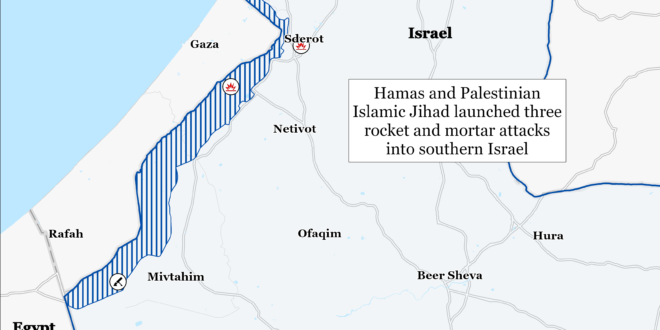Moderate politician Masoud Pezeshkian won the Iranian presidential runoff election on July 5.[i] Iranian media reported that Pezeshkian received over 16 million votes, while his opponent, ultraconservative hardliner Saeed Jalili, received approximately 13.5 million votes.[ii] Pezeshkian and Jalili won approximately 10.4 million and 9.5 million votes respectively in the first round of voting on June 28.[iii] The Iranian Election Headquarters announced that voter turnout in the runoff presidential election was 49.8 percent, marking an approximately 10 percent increase from the first round of elections on June 28.[iv] Pezeshkian will be inaugurated on an unspecified date between July 22 to August 5.[v]Pezeshkian’s presidency will mark a departure from hardline President Ebrahim Raisi’s presidency. Pezeshkian has repeatedly criticized Raisi’s presidency in recent weeks.[vi]
ADD NOTE
TWEET
Pezeshkian previously served as a senior health official in the reformist Mohammad Khatami administration from 2000-2005 and as a parliamentarian from 2008 to 2024.[vii] Pezeshkian hails from Mahabad, West Azerbaijan Province, and is fluent in Azeri and Kurdish.[viii] Pezeshkian is trained as a physician and served as a medic during the Iran-Iraq war from 1980 to 1988.[ix] He later served in the reformist Khatami administration as health and medical education minister.[x] Pezeshkian is currently a parliamentarian representing East Azerbaijan Province and has held this role for 16 years.[xi] He served as a deputy parliament speaker in 2016.[xii] Pezeshkian was disqualified from running in the 2021 presidential election, making his recent qualification and subsequent presidential win noteworthy.[xiii]
Pezeshkian will likely attempt to pursue nuclear negotiations with the West, although it is unclear to what extent Supreme Leader Ali Khamenei will permit him to do so. Pezeshkian called for increasing international engagement with Western actors and endorsed a return to the Joint Comprehensive Plan of Action (JCPOA) throughout his campaign.[xiv] Mohammad Javad Zarif, the foreign affairs minister under reformist president Hassan Rouhani who helped negotiate the JCPOA in 2015, has played a prominent role in Pezeshkian’s campaign, suggesting that Pezeshkian is committed to resuming negotiations.[xv] Pezeshkian separately supported resolving issues with the Financial Action Task Force (FATF).[xvi] The FATF blacklisted Iran in February 2020 for failing to implement anti-money laundering and counter-terrorist financing policies.[xvii] The Supreme Leader has previously expressed foreign policy and nuclear views that promote domestic production over economic engagement with the West, making it unclear to what extent Khamenei will permit Pezeshkian to engage with Western actors.[xviii] Khamenei has also indirectly criticized Pezeshkian’s campaign and has called on him to “continue [former hardline president Ebrahim] Raisi’s path” in his presidency.[xix]
Pezeshkian’s presidency is unlikely to generate meaningful changes within the regime. Pezeshkian supports regime policies like mandatory veiling. Pezeshkian has previously critiqued the Noor Plan—a 2024 Iranian law enforcement plan that often violently enforces veiling—but continues to support mandatory veiling within Iran and has argued that the regime must reform the way it educates girls so that they do not question the need to veil.[xx] Pezeshkian has also boasted about his role in enforcing mandatory veiling in hospitals and universities shortly after the Islamic Revolution.[xxi] Pezeshkian has repeatedly reiterated his commitment to enforcing Khamenei’s policies throughout his campaign. The president also lacks the authority to pursue policies different from the supreme leader’s edicts, even if the president aims to pursue policies separate from the supreme leader.[xxii]
Pezeshkian’s presidency suggests that Khamenei prioritized the regime’s legitimacy over his individual legacy in this instance. Khamenei implicitly criticized Pezeshkian’s campaign policies and espoused Jalili’s nuclear and foreign policy views in a speech on June 25, which suggested that Khamenei preferred Jalili over Pezeshkian.[xxiii] Khamenei previously paved the way for his preferred candidate, Ebrahim Raisi, to win the August 2021 presidential election.[xxiv] The fact that Khamenei allowed Pezeshkian to win the election suggests that Khamenei prioritized preserving the Islamic Republic’s veneer as a “religious democracy” over installing a president who more closely aligns with his hardline stances on domestic and foreign issues.
It is particularly noteworthy that Khamenei allowed Pezeshkian to win given that the next Iranian president may oversee Khamenei’s succession. Khamenei is currently 85 years old and has almost certainly begun to consider who will succeed him. That Khamenei allowed Pezeshkian to win suggests that he believes Pezeshkian could maintain order in the regime and Iranian society during a potential succession crisis. It also suggests that Khamenei prioritizes regime survival over having a president in power whose views and policies directly align with his own.
Khamenei may have calculated that manipulating the July 5 election results could stoke widespread unrest. The regime previously engineered the election results between reformist Mir Hossein Mousavi and hardliner Mahmoud Ahmadinejad in 2009, which galvanized a months-long anti-regime protest wave.[xxv] The regime might be particularly wary of public unrest given that it recently suppressed the 2022-2023 Mahsa Amini movement and that much of the Iranian population still holds sociocultural, political, and economic grievances against the regime.[xxvi]
Key Takeaways:
- Iran: Moderate politician Masoud Pezeshkian won the Iranian presidential runoff election on July 5. Pezeshkian’s presidency is unlikely to generate meaningful changes within the regime. It is noteworthy, however, that Khamenei allowed Pezeshkian to win given that the next Iranian president may oversee Khamenei’s succession.
- Ceasefire Negotiations: Anonymous Israeli officials said that the main sticking point in ceasefire negotiations centers around Article 14, which states that the United States, Egypt, and Qatar will “make every effort” to ensure negotiations end in an agreement and that a ceasefire is held as negotiations continue. Hamas seeks to remove the phrase “make every effort,” leaving only “ensure.”
- Gaza Strip: The Israeli Defense Forces (IDF) reported on July 6 that the 98th Division located a weapons warehouse in Shujaiya containing long-range rockets and explosive charges.
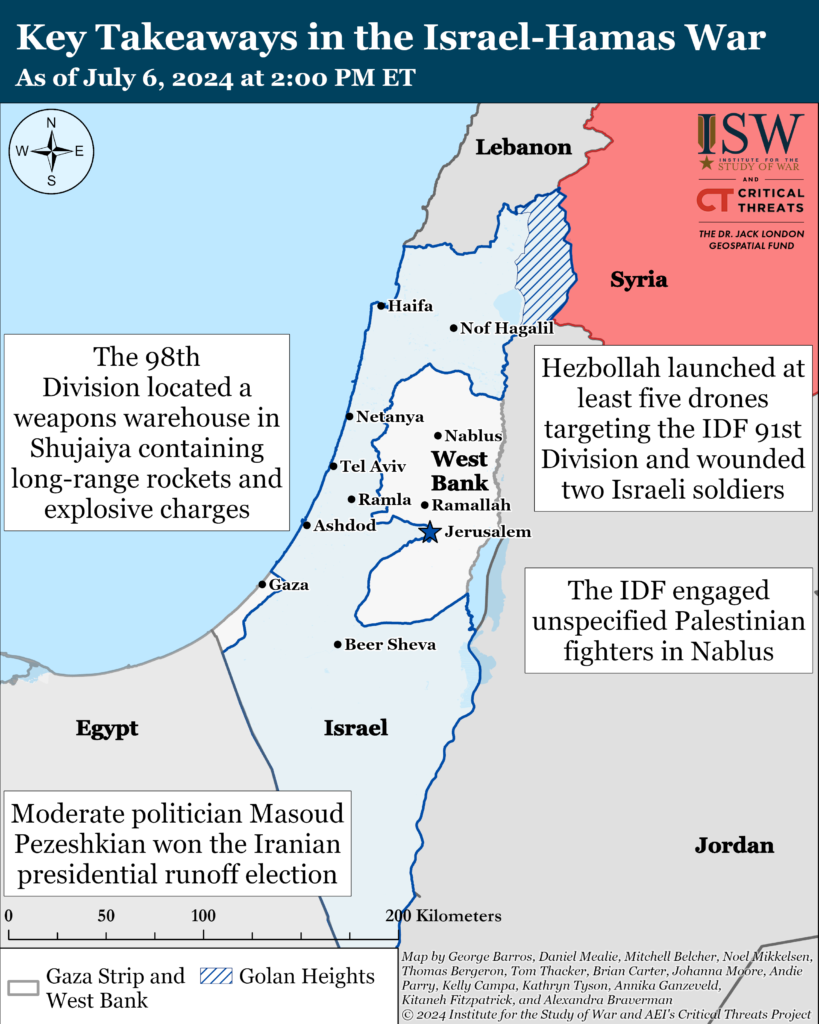
Gaza Strip
Axis of Resistance objectives:
Erode the will of the Israeli political establishment and public to sustain clearing operations in the Gaza Strip
Reestablish Hamas as the governing authority in the Gaza Strip
The Israeli Defense Forces (IDF) reported on July 6 that the 98th Division located a weapons warehouse in Shujaiya containing long-range rockets and explosive charges.[xxvii] The IDF has previously destroyed multiple weapons production facilities during its reclearing operation in Shujaiya, indicating that Hamas retains the capability to replenish materiel should it choose to do so.[xxviii] The 98th Division destroyed Palestinian militia infrastructure, including tunnels, and killed Palestinian fighters during operations in Shujaiya, Gaza City, on July 6.[xxix]
Hamas and other Palestinian militias continued to defend against Israeli operations in Shujaiya on July 6. Hamas fighters detonated an explosively formed penetrator targeting an Israeli Merkava tank in Shujaiya.[xxx] Hamas also targeted Israeli infantry with an anti-personnel mine.[xxxi] Palestinian Islamic Jihad (PIJ) said that its fighters targeted Israeli forces on al Khulafa Street in Shujaiya with unspecified weapons.[xxxii] PIJ claimed that the attack wounded and killed seven Israeli soldiers.
The IDF Air Force destroyed a Hamas rocket launch site that was located next to civilian shelters in a humanitarian zone in Deir al Balah on July 5.[xxxiii] The IDF provided civilians in the surrounding area with advanced warning to reduce civilian casualties in the strike.
PIJ and the al Aqsa Martyrs’ Brigades—the self-proclaimed militant wing of Fatah—have claimed five rocket and mortar attacks targeting IDF headquarters and soldiers in unspecified areas of the Netzarim Corridor since CTP-ISW’s last data cut off on July 5.[xxxiv]
The 162nd Division continued clearing operations in Rafah on July 6.[xxxv] The Nahal Brigade located Palestinian militia equipment and destroyed tunnels. The 401st Brigade directed an airstrike targeting Palestinian fighters who had fired on Israeli forces.
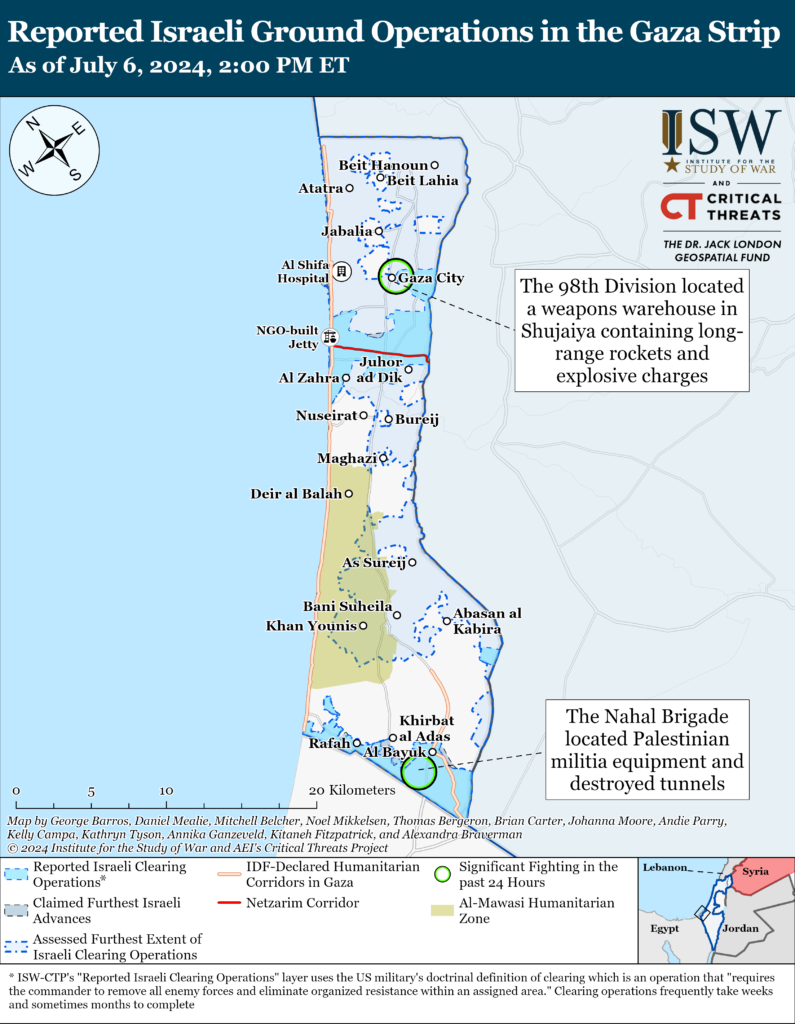
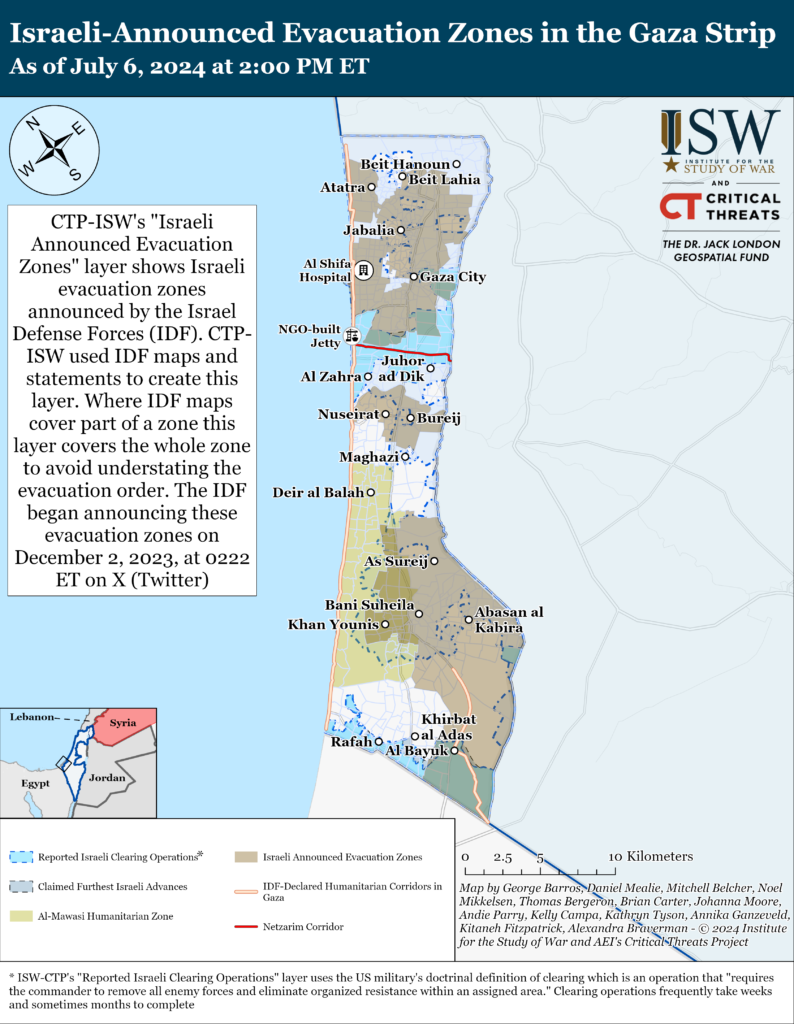
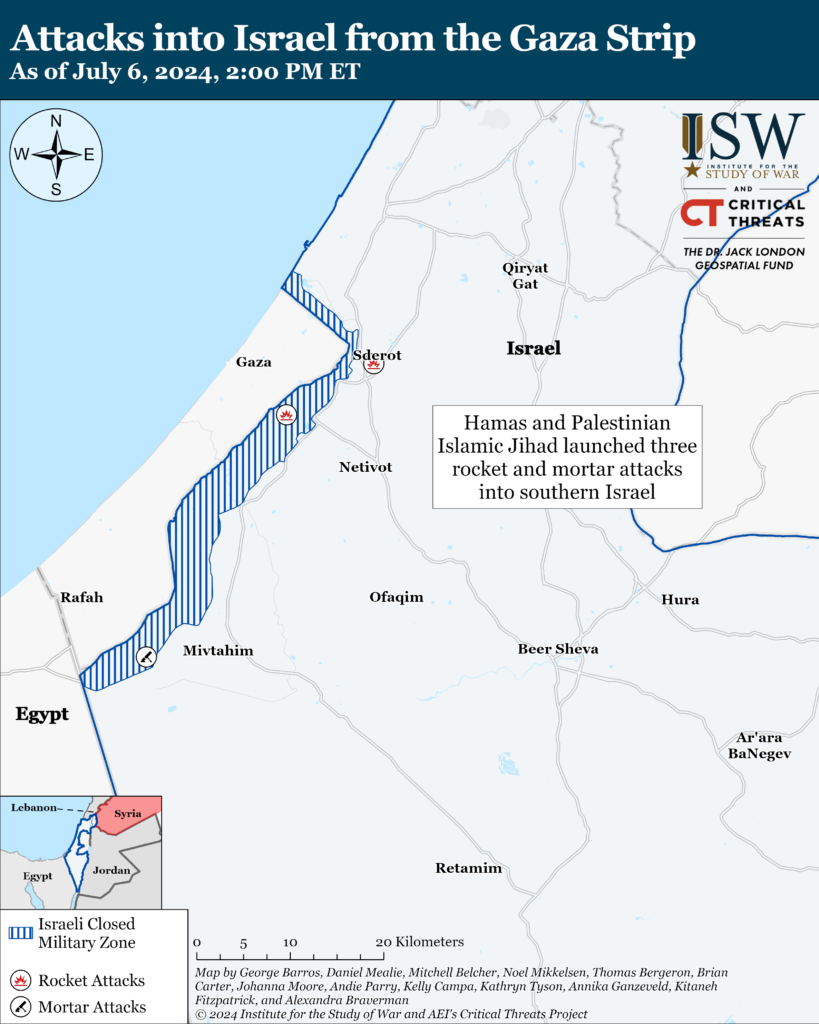
Hamas withdrew its previous demand that Israel commits to an end to the war and now demands that the US, Egypt, and Qatar commit to continue negotiations on the second phase of the deal without a specified timeframe.[xxxvi] Anonymous senior Israeli officials cited by Axios said that outstanding gaps between Israel and Hamas center on Article 14.[xxxvii] Article 14 states that the United States, Egypt, and Qatar will “make every effort” to ensure negotiations end in an agreement and that a ceasefire is held as negotiations continue. Hamas has demanded that the phrase be replaced by “ensure,” without the qualification of ”make every effort.”[xxxviii] Anonymous Israeli officials cited by Axios said that Hamas’ proposed language could draw out the second phase of the ceasefire deal indefinitely. The officials said that Mossad Director David Barnea is expected to tell mediators that Israel does not accept Hamas’ demand. Anonymous US officials cited by Axios said that the United States proposed to replace the phrase ”make every effort” with ”undertake” in response to Hamas’ proposed language. Israeli Prime Minister Bejamin Netanyahu’s office released a statement saying that Israeli mediators will return to Doha this upcoming week to continue talks.[xxxix] The Deputy Secretary General of Palestinian Islamic Jihad (PIJ) claimed that the IDF is ”exhausted” and willing to accept a deal at any price.[xl]
ADD NOTE
TWEET
Hamas and Palestinian Islamic Jihad launched three rocket and mortar attacks into southern Israel.[xli]
West Bank
Axis of Resistance objectives:
Establish the West Bank as a viable front against Israel
Israeli forces engaged Palestinian fighters in at least one location in the West Bank since CTP-ISW’s last data cut-off on July 5.[xlii]
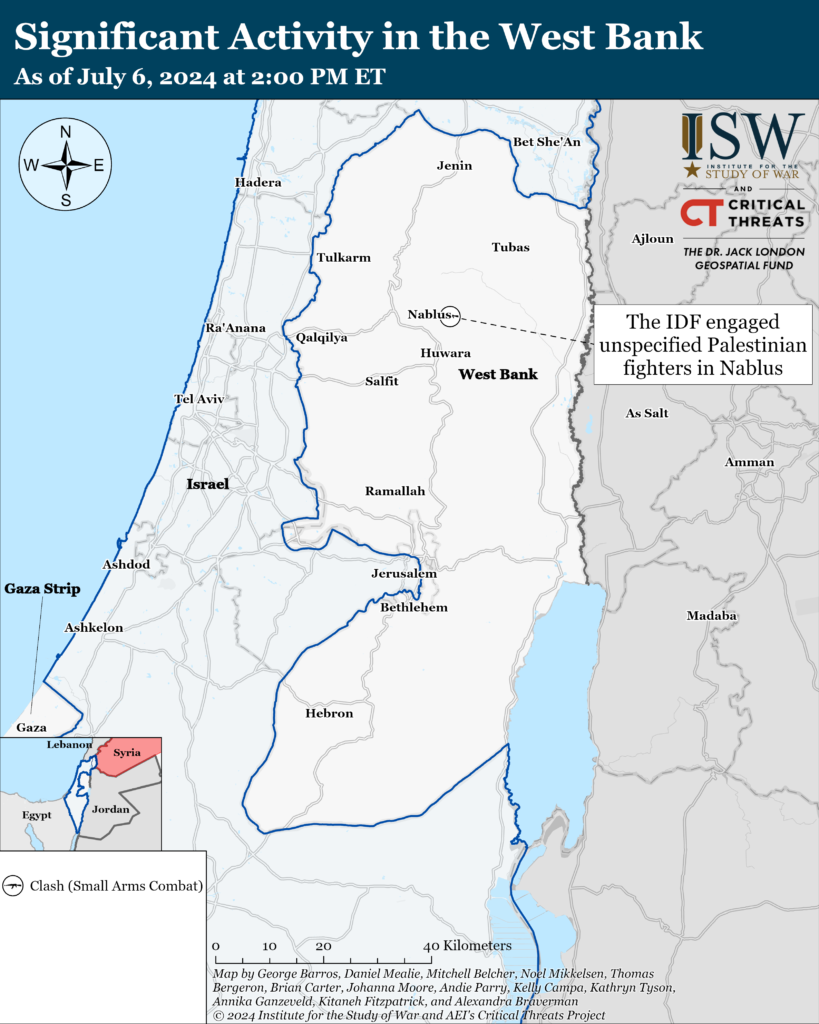
This map is not an exhaustive depiction of clashes and demonstrations in the West Bank.
Southern Lebanon and Golan Heights
Axis of Resistance objectives:
Deter Israel from conducting a ground operation into Lebanon
Prepare for an expanded and protracted conflict with Israel in the near term
Expel the United States from Syria
Lebanese Hezbollah conducted at least five attacks into northern Israel since CTP-ISW’s last data cut-off on July 5.[xliii]
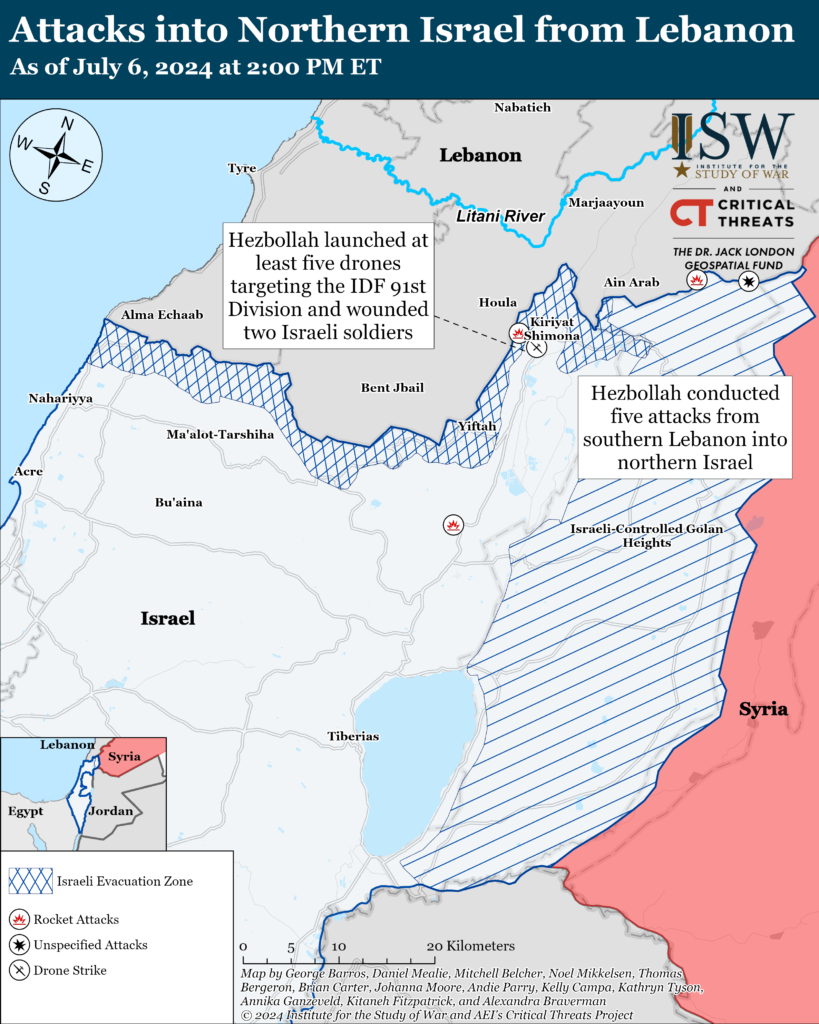
Recorded reports of attacks; CTP-ISW cannot independently verify impact.
 Eurasia Press & News
Eurasia Press & News
